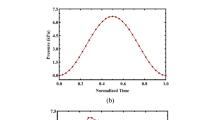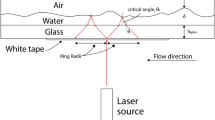Conclusions
-
1.
Ultrasound measurements employing piezoelectric transducers with exponential waveguides may be used for studying the structural features of bones.
-
2.
The isorapid zones of large tubular bones, specifically, the tibia, femur, and humerus, have a pronounced orientation with predominantly transverse extension in the epiphyses, longitudinal spiral configuration in the diaphyseal segment, and dentate pattern in the transition region.
-
3.
Acoustic plateau regions are found in the zones for the attachment of the large crural muscles with relatively low gradient of ultrasound velocity change.
-
4.
The transverse acoustic rigidity varies in magnitude, transverse configuration, and orientation relative to the major axes of the geometrical cross section of the bone over its length.
Similar content being viewed by others
Literature cited
F. G. Evans and H. R. Lissner,“‘Stresscoat’ deformation studies of the femur under static vertical loading,”Anatom. Record,100, 159–190 (1948).
F. Evans,“Methods of studying the biomechanical significance of bone form,”Am. J. Physical Anthropol.,11, 413–435 (1953).
V. N. Kryukov, V. S. Semennikov, V. É. Yankovskii, and G. T. Buguev,“The application of electrotensometric methods for the study of the physical properties of human bones,”in: Modern Laboratory Methods in Forensic Medicine [in Russian], Vol. 1, Moscow (1968), pp. 98–102.
J. Wagner, J. Ebbeni, and M. Clemens,“Application de l'interferometrie holographique a l'étude du complexe tibio-péronier chargé axialement,”Acta Orthop. Belg.,41, suppl. 1, 24–34 (1975).
E. Amtmann,“Bruchfestigkeitigkeitsverteilung in menschlicher Femurschaft,”Naturwissenschaften,55, No. 8, 392–393 (1968).
E. Antmann,“The distribution of breaking strength in the human femur,”J. Biomechanics,1, No. 4, 271–277 (1968).
I. Knets, J. Saulgozis, and H. Jansons,“On the nonuniformity of elastic properties and strength of human bone,”in: Proceedings of the Biomechanics Symposium, Atlanta, 1973, AMD, Vol. 2, p. 85.
Kh. A. Yanson, The Biomechanics of the Human Lower Extremity [in Russian], Riga (1975).
E. Ehler, C. Christman, and M. Pfan,“Der Einfluss der Inhomogenität auf die Knochenfestigkeit, Anat. Anz.,142, 512–518 (1977).
P. J. Atkinson and J. Weatherell, Variation in the density of the femoral diaphysis with age,”J. Bone Jt. Surg.,49-B, No. 4, 781–788 (1967).
V. V. Dzenis, A. A. Merten, V. K. Bernkhard, and V. V. Shumskii,“The application of surface ultrasound waves for studying the properties of human tibial bones,”Mekh. Polim., No. 4, 674–679 (1975).
I. V. Knets and V. V. Dzenis,“The correlation between ultrasound wave velocity and mechanical indices of human bone tissue,”Mekh. Polim., No. 5, 906–910 (1975).
A. A. Merten, V. V. Dzenis, V. V. Shumskli, V. K. Bernkhard, and G. A. Yankovskii,“An ultrasound study of the effect of physical load on the state of human tibial bones,”Mekh. Polim., 1079–1083 (1976).
V. V. Shumskii, A. A. Merten, and V. V. Dzenis,“An ultrasound study of the effect of the type of physical load on the state of the tibial bones of highly accomplished athletes,”Mekh. Polim., No. 5, 884–888 (1978).
I. V. Knets, G. O. Pfafrod, and Yu. Zh. Saulgozis, The Deformation and Rupture of Hard Biological Tissues [in Russian], Riga (1980).
E. D. Sedlin and C. Hirsch,“Factors affecting the determination of the physical properties of femoral cortical bone,”Acta Orthopaed. Scand.,37, 29–48 (1966).
N. L. Leont'ev, Techniques in Statistical Calculations [in Russian], Moscow (1966).
K. A. Brownlee, Statistical Theory and Methodology in Science and Engineering [Russian translation], Moscow (1977).
A. F. Kregers,“Dispersion analysis of a multifactorial uniform statistical complex,”Algoritmy i Programmy, No. 1, 21 (1975).
Author information
Authors and Affiliations
Additional information
Translated from Mekhanika Kompozitnykh Materialov, No. 4, pp. 719–727, July–August, 1983.
Rights and permissions
About this article
Cite this article
Yanson, K.A., Dzenis, V.V., Kregers, A.F. et al. Structural features of human tubular bones relative to ultrasound measurements. Mech Compos Mater 19, 542–549 (1984). https://doi.org/10.1007/BF00603918
Received:
Issue Date:
DOI: https://doi.org/10.1007/BF00603918




